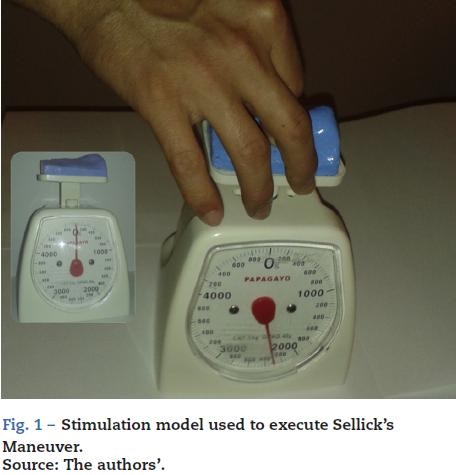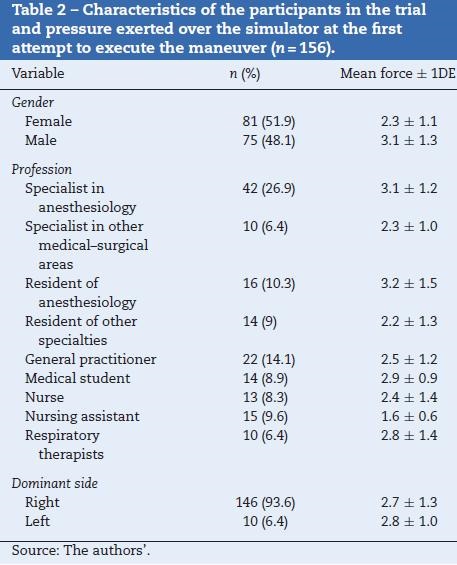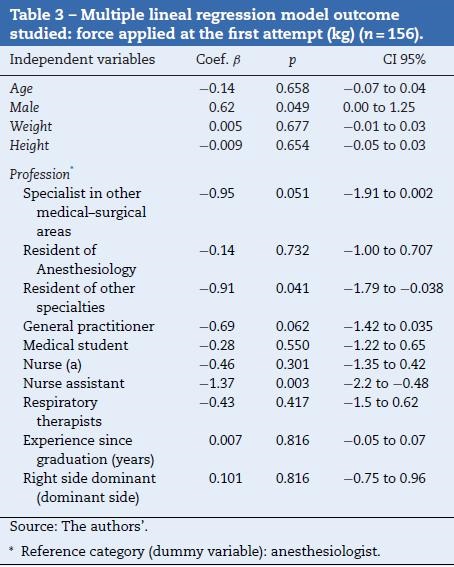Serviços Personalizados
Journal
Artigo
Indicadores
-
 Citado por SciELO
Citado por SciELO -
 Acessos
Acessos
Links relacionados
-
 Citado por Google
Citado por Google -
 Similares em
SciELO
Similares em
SciELO -
 Similares em Google
Similares em Google
Compartilhar
Colombian Journal of Anestesiology
versão impressa ISSN 0120-3347
Rev. colomb. anestesiol. vol.41 no.4 Bogotá out/dez. 2013
https://doi.org/10.1016/j.rca.2013.09.004
Scientific and technological research
Pressure applied by the healthcare staff on a cricoid cartilage simulator during Sellick's maneuver in rapid sequence intubation*'*
Fuerza aplicada por el personal de salud sobre un simulador del cartílago cricoides durante la realización de la maniobra de Sellick en la intubación de secuencia rápida
Jose Andres Calvachea'*, Maria Ximena Sandovalb, William Andres Vargasc
a Professor, Department of Anesthesiology, University of Cauca, Popayan, Colombia, Anesthesiology/Biostatistics Departments, Erasmus University Medical Centre, Rotterdam, The Netherlands
b Anesthesiologist, San José University Hospital, Popayan, Colombia
c Resident 111 Anesthesiology, University of Cauca, Popayan, Colombia
* Please cite this article as: Calvache JA, Sandoval MX, Vargas WA. Fuerza aplicada por el personal de salud sobre un simulador del cartílago cricoides durante la realización de la maniobra de sellick en la intubación de secuencia rápida. Rev Colomb Anestesiol. 2013;41:261-266..
* This paper was awarded third place during the Jorge Luis Colmenares Competition, XXX National Congress of Anesthesiology -S.C.A.R.E., 2013.
* Corresponding author at: Department of Anesthesiology, University of Cauca, University Hospital San José, Third Floor, Popayán, Colombia.
E-mail address jacalvache@gmail.com (J.A. Calvache).
ARTICLE INFO
Article history: Received 10 July 2013 Accepted 1 September 2013 Available online 19 October 2013
ABSTRACT
Background: Sellick's maneuver or cricoid pressure is a strategy used to prevent bronchoaspiration during the rapid intubation sequence. Several studies have described that the force required for an adequate maneuver is of 2.5-3.5 kg. The purpose of this paper was to determine the force applied (in kilograms) on a cricoid cartilage simulator by the healthcare professionals.
MethodoIogy: Observational cross-section trial. The participants were the healthcare professionals at the San José University Hospital in Popayán and participants at the National Congress of Anesthesiology - S.C.A.R.E. 2011, who were conveniently selected. Every participant made three attempts to apply the maneuver on the simulator.
Results: Data from 156 participants were collected. The mean global pressures applied in the first, second and third attempts were 2.70, 2.71 and 2.73kg, respectively. Following a multivariate adjustment, males exhibited a higher force at the first attempt to do the maneuver. No association was found to other variables, such as labor experience or the training level. Conclusions:The pressure applied by the participants in the trial during the first attempt was 2.7 kg. Most of the subjects in the trial did Sellick's maneuver applying an inadequate pressure in their first attempt. Only males exerted an overpressure in their first attempt to do the maneuver.
© 2013 Sociedad Colombiana de Anestesiología y Reanimación. Published by Elsevier España, S.L. All rights reserved.
Keywords: Intubation, Cricoid cartilage, Simulation, Trachea, Airway management
RESUMEN
Antecedentes: La maniobra de Sellick o fuerza cricoidea es una estrategia utilizada para prevenir broncoaspiración durante la secuencia rápida de intubación. Algunos estudios han descrito que la fuerza necesaria para que la maniobra sea adecuada es de 2,5 a 3,5 kg. Esteestudio tuvo como objetivo determinar cuál es la fuerza ejercida (en kilogramos) sobre un simulador del cartílago cricoides por profesionales de la salud.
Metodologia: Estudio observacional de corte transversal. Los participantes fueron personal de salud del Hospital Universitario San José de Popayán y asistentes al Congreso Nacional de Anestesiología S.C.A.R.E. 2011, los cuales fueron seleccionados a conveniencia. Cada participante ejecutó 3 intentos de realización de la maniobra sobre el simulador.
Resultados: Se recolectaron datos de 156 participantes. La fuerza global media ejercida en el primer, segundo y tercer intento de realización fue de 2,70, 2,71 y 2,73 kg, respectiva-mente.Tras el ajuste multivariante, el género masculino presentó influencia en la mayor aplicación de fuerza en el primer intento de realización de la maniobra. No se encontró asociación con otras variables como la experiencia de trabajo o el grado de entrenamiento.
Conclusiones: La fuerza ejercida por los participantes en el estudio durante el primer intento fue de 2,7 kg. La mayoría de los sujetos en estudio realizaron la maniobra de Sellick con unafuerza inadecuada en el primer intento. Únicamente el género masculino afecta la fuerzarealizada por los profesionales en el primer intento de realización de la maniobra.
© 2013 Sociedad Colombiana de Anestesiología y Reanimación. Publicado por Elsevier España, S.L. Todos los derechos reservados.
Palabras clave: Intubación, Cartílago cricoides, Simulación, Tráquea, Manejo de la Vía aérea
Introduction
Sellick's maneuver is the pressure applied on the cricoid cartilage for pushing the trachea and compressing the esophagus against the cervical vertebrae in an attempt to occlude gas-troesophageal reflux.1 The technique has been used widely since the sixties when it was included in the description of rapid sequence intubation.2 The current recommendation for its use in the management of anesthesia in patients with a full stomach and/or during rapid sequence intubation is Classification D; there is nevertheless considerable controversy regarding its use and clinical efficacy.3,4 However, in view of its broad availability, little resources needed for its implementation and low risks, it is still a frequently used tool during the process of intubation.
During the eighties, Wraight & Cols measured the force that should be applied over the cricoid cartilage to prevent saline reflux through a tube inside the esophagus. They estimated that the pressure required to prevent bronchoaspiration was 44 N.5 Some authors argue that the maneuver is only effective if applied properly. Clayton and Vanner observed that the pressure applied over the cricoid changed depending on the force applied by the operator and on the training in the execution of the maneuver. Consequently, a force of 25-35 N over the cartilage (or the equivalent weight of 2.5-3.5 kg - taking the cricoid area into account) has been used as a strategy for proper execution of the maneuver.6
Studies using simulators have shown that anesthesiology assistants in the first two attempts to execute the maneuver did not apply enough force; however, following a training period, the force applied was close to the recommendation.7
Notwithstanding the lack of clear evidence about the clinical effectiveness of Sellick's maneuver to prevent the risk of bronchoaspiration, its potential benefit may be associated to the anatomic characteristics of each particular patient, the training received by the operator in the application of force over the cricoid, the knowledge of the maneuver and/or the relationship of the esophagus, the cricoid and the cervical spine.8-10
In our environment, we do not have any data available on the use of Sellick's maneuver in rapid sequence induction or on the characteristics of its use. Consequently, the objectives of this paper were: to estimate in kilograms the force applied by the various healthcare professionals over a simulator ofthe cricoid cartilage when executing Sellick's maneuver, to characterize the differences among them and to establish potential factor affecting the force applied.
Materials and methods
Observational, cross-section trial that included healthcare staff at the San José University Hospital, Popayán, and voluntary participants at the National Congress of Anesthesiology -S.C.A.R.E. 2011. The sample included residents of anesthesiol-ogy and other specialties throughout the country, specialists in anesthesia and in other areas, general practitioners, medical students, OR assistants, respiratory therapists and chief nurses.
Everyone agreed to participate and submitted their voluntary informed consent; the ethics committee of the San José University Hospital of Popayán approved the trial.
The researchers were in charge of recording the data in a form that included the force applied in three attempts, the name, age, gender, size, weight, length of labor experience, profession, dominant side and position at the time of doing the maneuver, in accordance with the protocol established by the group of researchers. The participants were blind to the force they applied at each attempt.
The simulation model used was a telemetry - scale Zhong-shanoppel Electronics CO, Xinlongstreet-Xincun, Eastarea, Zhongshan (Kitchen Scale) used for weighing objects, that was calibrated with known weights, bought and installed on 01-042010 and date of commissioning 04-03-2011 (code ECRI10-264, cost of the unit: COP$ 95 000). The assistant of biomedical devices that works at the San José University Hospital, using a synthetic plastic fiber that simulates the consistency of the cricoid cartilage, manufactured the model of the cricoid cartilage area. A biomedical engineer supervisor, who works at the Health Department of Cauca, confirmed the calibration of the simulator in kilograms and designed a chart that verified and certified that the measurements collected from each participant were valid and within the range of variability allowed to meet quality standards (Fig. 1).
Upon approval to join the trial, Sellick's maneuver was explained to every participant and the data corresponding to the three attempts were then collected but the participant remained blind to the results recorded by the machine.
The analysis were made using a software SPSS 19.0 (IBM SPSS Statistics for Windows, Version 19.0. Armonk, NY: IBM Corp.) and R (R Development Core Team (2008). R: A language and environment for statistical computing. R Foundation for Statistical Computing, Vienna, Austria. ISBN 3-900051-07-0, URL http://www.R-project.org.). To summarize the quantitative variables such as age, weight, height and the force applied in kilograms, general trends and scatter measurements were used (average ± standard deviation, median
[interquartile range], value {minimum-maximum}). Absolute and proportionate frequencies were used for the qualitative variables.
The relevant results are shown graphically using box diagrams, point charts and correlation matrixes. The level of Pearson's lineal correlation was established among three consecutive evaluations in the same participant and 95% confidence intervals were calculated for those correlations using bootstrapping. Finally, a multiple lineal regression model was developed to explore the association of co-variables in the trial with the force applied in the first attempt to execute the maneuver. A residual analysis was made to assess the adjustment of the model. A statistical alpha significance level of 0.05 was set for all the analyses.
Results
156 participants were gathered during a period of 18 months; the overall characteristics of the participants are shown in Table 1. Most of them were females (52%) and professional anesthesiologists (27%).
The median force applied in the first, second and third attempt were 2.70, 2.71 and 2.73 kg, respectively (Fig. 2).
The correlation of force applied in the three repeated evaluations was very high and it was even higher in subsequent evaluations between the first and the second R2 = 0.92 95% CI [0.86-0.95]. Very few outliers were found. The correlation matrix is shown in Fig. 3.
Males executed the maneuver with an average force of 3.1 kg and females with 2.3 kg. The mean force applied by the various professionals in the trial is shown in Table 2 and Fig. 4 is a graphical representation thereof.
The force applied during the first attempt to executethe maneuver showed a distribution with no evidence ofabnormality (Hosmer Lemeshow p ≥ 0.05). The multiple linealregression analysis, ˇ coefficients and their respective 95%confidence intervals are all shown in Table 3. The finalmodel accomplished an R2of 18% (Fisher test (14, 141) = 2.22,p = 0.009) (Table 3). The residual analysis showed no evi-dence of abnormality or poor adjustment of the regressionmodel.
DiscussionThe force required for the adequate execution of Sellick’smaneuver ranges from 2.5 to 3.5 kg. 6 This trial showed that as opposed to other participants, most anesthesiologists and anesthesiology residents apply higher levels of force at their first attempt. However, most of the subjects studied apply inadequate force and this fact has been confirmed by various trials around the world.11,12 Research done with simulation devices have indicated that anesthesiology assistants and nursing staff require a short training period to be able to apply a level of force close to the recommendation that may be replicated afterwards.7 These findings point to an opportunity to educate healthcare staff in anesthesia maneuvers.
It is interesting - though not unexpected - that the pressure applied at each attempt is highly correlated, and even more in subsequent evaluations. Generally speaking, other participants applied less pressure in their first attempt as compared to anesthesiologists, many of which were outside the recommended range. Thus, the regression model shows that residents from other specialties, other medical specialists, general practitioners and nursing assistants, exert far less pressure in their first attempt as compared to anesthesiologists.
When exploring the influence of other variables, only males showed a significant association with higher force at their first attempt. However, no evidence could be found with regards to an association with the professional experience, age, anthropometric characteristics or the dominant side.
Since this was an observational trial its validity could be affected by potential biases. The method for recruiting the participants, the fact that they were blinded to the force applied over the simulator and the logistic characteristics of each individual evaluation, may have introduced selection or information biases, respectively. These potential pitfalls should be taken into consideration when evaluating the applicability or generalization of the results to other populations.
Conclusions
The force applied by the participants in the trial at their first attempt was 2.7 kg. Most of the participants in the trial executed Sellick's maneuver with inadequate force at their first attempt. Only males have an impact on the force applied by professionals in their first attempt to do the maneuver.
Funding
Authors' resources.
Conflict of interests
The authors have no disclosures to make.
Acknowledgement
The author wish to thank the editorial center of the School of Sciences or the University of Cauca for their contribution in editing this manuscript.
1. Sellick BA. Cricoid pressure to control regurgitation of stomach contents during induction of anaesthesia. Lancet. 1961;2:404-6. [ Links ]
2. Stept WJ, Safar P. Rapid induction/intubation for prevention of gastric-content aspiration. Anesth Analg. 1970;49:633-6. [ Links ]
3. Neilipovitz DT, Crosby ET. No evidence for decreased incidence of aspiration after rapid sequence induction. Can J Anaesth. 2007;54:748-64. [ Links ]
4. Páez L, Navarro JVR. Controversial issue of cricoid pressure or Sellick maneuver. Rev Colomb Anestesiol. 2010;38:370-5. [ Links ]
5. Wraight WJ, Chamney AR, Howells TH. The determination of an effective cricoid pressure. Anaesthesia. 1983;38:461-6. [ Links ]
6. Clayton TJ, Vanner RG. A novel method of measuring cricoid force. Anaesthesia. 2002;57:326-9. [ Links ]
7. Ashurst n, Rout CC, Rocke DA, Gouws E. Use of a mechanical simulator for training in applying cricoids pressure. Br J Anaesth. 1996;77:468-72. [ Links ]
8. Priebe HJ. Cricoid pressure: An alternative view. Semin Anesth Per Med Pain. 2005;24:120-6. [ Links ]
9. Smith KJ, Dobranowski J, Yip G, Dauphin A, Choi PT. Cricoid pressure displaces the esophagus: An observational study using magnetic resonance imaging. Anesthesiology. 2003;99:60-4. [ Links ]
10. Herman NL, Carter B, van Decar TK. Cricoid pressure: Teaching the recommended level. Anesth Analg. 1996;83:859-63. [ Links ]
11. Howells TH, Chamney AR, Wraight WJ, Simons RS. The application of cricoid pressure. An assessment and a survey of its practice. Anaesthesia. 1983;38:457-60. [ Links ]
12. Kopka A, Crawford J. Cricoid pressure: a simple yet effective biofeedback trainer. Eur J Anaesthesiol. 2004;21:443-7. [ Links ]











 texto em
texto em 






